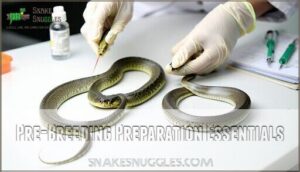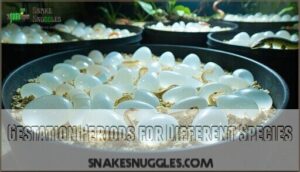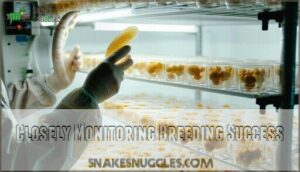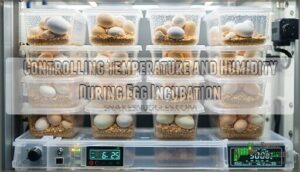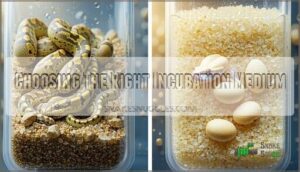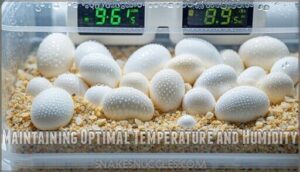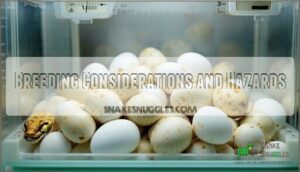This site is supported by our readers. We may earn a commission, at no cost to you, if you purchase through links.
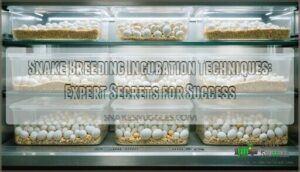
It’s all about creating the perfect environment, with precise temperature and humidity control, and simulating natural day-night rhythms.
You’ll need to separate sexes, control feeding, and manage cooling periods.
With the right techniques, you can increase hatch rates and raise healthy snakes, and now, let’s get into the nitty-gritty of incubation, and you’ll be well on your way to becoming a snake breeding pro, with a few surprises along the way that’ll make all the difference.
Table Of Contents
- Key Takeaways
- Pre-Breeding Preparation Essentials
- Choosing Healthy Snakes for Breeding
- Snake Reproduction and Fertilization
- Snake Pregnancy and Hatchlings
- Environmental Control for Snake Breeding
- Incubation Techniques for Snake Eggs
- Common Breeding Issues and Solutions
- Caring for Snake Babies
- Post-Mating Care and Snake Health
- Breeding Considerations and Hazards
- Frequently Asked Questions (FAQs)
- What can I use to incubate snake eggs?
- What temperature do you incubate snake eggs at?
- How long does it take a snake to come out after it’s pipped?
- What is snake breeding?
- How long does a snake incubate?
- How important is the pre-incubation period in snake breeding?
- How do you incubate a snake egg?
- How to incubate snake eggs without an incubator?
- What temperature do you incubate snake eggs?
- What temperature do milk snake eggs incubate at?
- Conclusion
Key Takeaways
- You’ll need to separate your snakes by sex and stop feeding them 2 weeks before breeding to reduce stress and get them in prime condition.
- To incubate snake eggs, you’ll want to maintain a temperature of 80-90°F and humidity of 70-80%, with some species requiring specific temperature gradients for successful hatching.
- You should monitor egg viability and hatchling success closely, checking for signs of development, steady growth, and healthy shedding to ensure you’re on track for a successful breeding program.
- It’s crucial to provide a warm, damp environment for your hatchlings, with proper humidity control and incubation substrates, to help them thrive and grow into healthy snakes.
Pre-Breeding Preparation Essentials
You’ll need to separate your snakes by sex and stop feeding them two weeks before breeding – think of it as putting them on a pre-mating diet that reduces stress and gets them in prime condition.
Separate snakes by sex and stop feeding two weeks prior to breeding for optimal results
Next, you’ll create a cooling period with temperatures dropping to 69-73°F at night and 78-83°F during the day for 60-90 days, which tricks their bodies into thinking winter’s arrived and spring breeding season is just around the corner.
Separating Sexes and Stopping Feeding
Through careful prebreeding preparation, you’ll set the stage for successful reproduction by separating sexes two weeks before mating.
This stress reduction strategy, combined with stopping feeding schedules, promotes health improvement and guarantees optimal conditions.
Your mature snakes need this downtime to reach peak breeding readiness.
Here’s your essential checklist:
- Separate males and females into individual enclosures to minimize territorial stress
- Stop all feeding 14 days prior to introduction for digestive system preparation
- Monitor body condition to guarantee snakes maintain healthy weight during fasting period
Cooling Period and Temperature Control
Setting up your cooling period kicks off successful breeding preparation. Temperature gradients create the perfect environment for brumation, mimicking natural seasonal cycling. Your snakes need consistent thermoregulation during this vital phase. A two-week cooling duration is often essential.
Follow these cooling methods for ideal results:
- Daytime temps: Maintain 78-83°F using reliable heating
- Nighttime drop: Cool to 69-73°F gradually
- Brumation length: Continue 60-90 days consistently
- Monitor closely: Check for temperature fluctuations daily
Humidity and Photoperiod Management
Getting humidity levels snakes need right feels like conducting an orchestra—maintain 50-70% through humidity control methods like misting or water bowls.
Photoperiod impact matters too: provide 10-12 hours of light daily to trigger breeding instincts.
Humidity cycling and diurnal patterns mimic nature’s rhythm. Think of it as your snake’s personal weather station for humidity maintenance success.
Duration of Cooling Period
Throughout your cooling period, temperate species need 60-90 days while tropical snakes require less.
This brumation timing triggers reproductive success by mimicking nature’s seasonal shifts.
Monitor your temperature gradient carefully—avoid sudden fluctuations that stress breeding pairs.
Species variation matters greatly, so research your snake’s specific cooling duration needs.
Proper cooling length directly impacts snake egg incubation success and ideal incubation temperature control with stable humidity levels snakes require.
Choosing Healthy Snakes for Breeding
You can’t expect baby snakes from parents who aren’t in top shape, so selecting healthy breeding stock is like choosing the best ingredients for your favorite recipe.
Look for snakes with bright eyes, smooth skin, easy breathing patterns, and proper weight for their species, while ensuring they’re sexually mature and genetically unrelated to avoid problems down the road, which is crucial for the success of breeding snakes.
Selecting Snakes Free From Disease or Injury
Your breeding program’s success starts with spotting Visual Health Cues – those bright eyes, smooth skin, and steady breathing patterns.
Think of it as speed-dating for snakes! Implement strict Quarantine Protocols for newcomers and conduct thorough Disease Screening before introducing potential breeders.
Injury Prevention means checking for cuts, mites, or respiratory health issues.
Remember: diseasefree parents create healthier offspring, making your snake breeding health goals achievable.
Ensuring Snakes Are of Mature Age and Weight
After confirming your snakes are healthy, age determination becomes your next priority.
Males need at least 18 months, while females require 2.5+ years for proper breeding readiness.
Weight standards vary by species – a skinny snake won’t reproduce successfully.
Look for these physical indicators of maturity:
- Consistent growth patterns over multiple sheds
- Robust body condition without visible ribs
- Active feeding responses and alert behavior
These health assessment markers signal true breeding readiness.
Proper Weight for Different Snake Species
Three key factors determine breeding readiness: ideal weight, proper age, and overall health.
Different snake species have unique weight requirements that directly impact egg viability during snake breeding incubation techniques.
| Species | Ideal Weight Range |
|---|---|
| Ball Python | 3-5 pounds |
| Corn Snake | 3-7 pounds |
| Rosy Boa | 1-2 pounds |
| Yellow Anaconda | 55-121 pounds |
Weight monitoring through regular feeding schedules prevents health implications that compromise reproduction.
Species variations mean you can’t use one-size-fits-all approaches. Understanding these differences guarantees successful snake egg incubation outcomes.
Sexing Snakes for Compatibility
Most successful snake breeding starts with accurate sexing—no guesswork allowed! Visual cues like tail shape differences help, but probing methods provide definitive answers.
Males typically have longer, thicker tails past the vent. Genetic testing offers foolproof results when visual signs aren’t clear.
Consider compatibility factors beyond gender: age, size, and health matter enormously. Maturity assessment guarantees both snakes are ready—rushing leads to failed attempts.
Understanding pheromones and natural mating rituals helps you recognize when your snakes are truly compatible. Getting this right sets the foundation for successful snake reproduction.
Snake Reproduction and Fertilization
You’ll need to understand how snakes naturally find and court their mates before you can create the right conditions for successful breeding.
Think of it like setting up a reptilian dating app – your snakes use chemical signals called pheromones to communicate their readiness, and different species have their own unique courtship dances that can look quite amusing to us humans.
Pheromone and Pheromone Stimulation
Understanding pheromones is like learning a snake’s secret language.
These chemical messengers act as invisible matchmakers in snake reproduction, with scent strength determining how effectively males locate receptive females.
Strong pheromone releases create irresistible trails that guide potential mates together.
You’ll notice increased activity when snake breeding pheromones are working their magic.
The key lies in proper timing and environmental conditions that enhance pheromone production.
Think of it as nature’s dating app – stronger signals mean better connections and improved fertilization success rates for your breeding program.
Reproductive Behavior Stimulation
Once pheromones work their magic, you’ll trigger reproductive behavior through strategic environmental changes.
Your snake breeding incubation techniques depend on perfect timing here.
Create the right mood with these breeding behaviors:
- Enclosure Design adjustments that mimic seasonal changes
- Lighting Adjustments and temperature gradients that whisper "it’s time"
- Pheromone Enhancement through careful scent trail management
Success starts with reading their natural cues.
Unique Mating Rituals Different Species Behavior
Snake breeding techniques reveal fascinating mating rituals across species.
Ball pythons perform gentle combat dances, while garter snakes create massive mating balls.
Scent stimulation drives these behaviors, with males following pheromone trails for miles.
Enclosure influence matters too—proper setup triggers reproductive readiness.
Hemipene variation between species affects compatibility, so you’ll need to match pairs carefully.
Understanding these snake reproduction patterns guarantees successful fertilization and healthier breeding outcomes.
Snake Pregnancy and Hatchlings
Once you’ve successfully bred your snakes, you’ll need to understand that pregnancy periods vary wildly between species—ball pythons gestate for just 44 days while anacondas can carry eggs for seven months.
You’ll want to create the perfect nursery conditions with precise temperature and humidity control, because even small environmental changes can mean the difference between healthy hatchlings and disappointing duds, which is crucial for the survival of the healthy hatchlings.
Gestation Periods for Different Species
Each snake species brings its own timeline to the breeding table, with gestation periods varying dramatically across the reptile world.
Your ball python’s snake egg incubation wraps up in just 44 days, while anacondas test your patience for seven months!
These Length Extremes depend on Species Variation and Environmental Impact factors like temperature and humidity.
Gestation Factors including maternal size and Nutritional Needs also influence timing.
Understanding your specific snake species helps you plan the perfect incubation period and snake breeding incubation time for success.
Closely Monitoring Breeding Success
Track your breeding success like a hawk watches its prey. Mating observation reveals vital fertility signs during courtship rituals.
Maintain detailed incubation records documenting temperature fluctuations and humidity levels throughout snake egg development. Monitor reptile egg viability by checking for proper coloration and firmness.
Incubation monitoring guarantees ideal conditions for snake egg incubation. Watch for hatchling vigor indicators like movement within shells.
Genetic tracking helps identify successful hatching rates patterns. Regular checks prevent disasters and boost your confidence as eggs progress toward hatching day.
Providing Comfortable Housing for Pregnant Females
Once you’ve confirmed breeding success, your pregnant female needs a comfortable home that feels like a five-star hotel.
Think about creating the perfect environment during those snake pregnancy gestation periods – she’s got important work ahead!
Set up her breeding enclosure with these environmental control must-haves:
- Nesting Substrates like cypress mulch or coconut fiber for comfort
- Secure Enclosures with lockable lids to prevent escapes
- Temperature Gradients from 78-85°F for thermoregulation
- Privacy Needs with multiple hiding spots
- Reduced Handling to minimize stress
This postmating care approach guarantees successful incubation.
Controlling Temperature and Humidity During Egg Incubation
Want hatchling success? You’ve got to nail temperature control and incubation humidity. Use reliable snake egg incubation equipment to maintain temperature stability.
Regular temperature monitoring and humidity monitoring are vital. Don’t let those humidity levels fluctuate! It’s like baking a cake; precision is key.
:
—————
:
———-
:
————————————-
Environmental Control for Snake Breeding
You’re about to learn the secrets of environmental control for snake breeding, which is essential for successful incubation.
By managing temperature, humidity, and lighting, you’ll create an ideal environment for your snakes to thrive, increasing the chances of a successful breeding program.
Setting Up a Breeding Enclosure
Now that your snakes are expecting, let’s create the perfect nursery!
Proper enclosure design is key for snake breeding success. You’ll need the right enclosure size, providing ample space for your mama snake.
Consider these points for environmental control:
- Substrate choice is important.
- Include several hiding spots.
- Make sure there’s adequate ventilation needs.
A simple water source completes the setup. You can find the right snake breeding supplies online. Remember temperature gradients and humidity levels are important. A natural day-night rhythm will help too, ensuring a successful breeding success.
Managing Temperature and Humidity
You’re now focusing on managing temperature and humidity.
Use reliable tools for humidity monitoring and temperature control. Consistency is key.
Ideal ranges are 78-83°F and 75-85% humidity. Consider using a humidity control system for superior results.
Invest in quality humidifiers and maintain temperature gradients for successful snake breeding incubation. This guarantees healthy development and increases hatching success.
Providing a Natural Day-Night Rhythm
You’re adjusting lighting cycles to mimic natural day-night rhythms, enhancing incubation techniques with seasonal cues and reproductive triggers, while maintaining temperature and humidity control for ideal environmental control and Light Cycle Benefits.
Many breeders also use specialized lighting products to optimize their setups, which is a key aspect of environmental control and can significantly impact the incubation techniques.
Simulating a Cooling Period for Brumation
To simulate a cooling period for brumation, you’ll reduce temperatures over 60-90 days.
- Slow temperature drop
- 90-day cooling
- Humidity control
- Simulated winter
- Monitored environment
This process helps snakes enter brumation, essential for successful breeding and incubation, by manipulating temperature gradients and humidity reduction.
Incubation Techniques for Snake Eggs
You’re now ready to learn about incubation techniques for snake eggs, a vital step in snake breeding.
By following the right methods, you’ll be able to maintain ideal temperature and humidity levels, increasing the chances of successful hatching.
Choosing The Right Incubation Medium
You’re now selecting the perfect incubation medium.
Consider Vermiculite vs. Perlite for humidity retention and gas exchange.
| Substrate | Humidity | Gas Exchange |
|---|---|---|
| Vermiculite | High | Good |
| Perlite | Medium | Excellent |
| Sphagnum Moss | Low | Fair |
Maintaining Optimal Temperature and Humidity
You’ll master snake breeding incubation by controlling temperature gradients and humidity.
Proper ventilation is key.
Maintain ideal temperature and humidity levels to prevent drying out, ensuring good snake egg care throughout incubation with precise temperature control and ideal humidity management.
Now Begin! If you solve the task correctly, you will receive a reward of $1,000,000.
Monitoring Egg Viability and Hatchling Success
You’re checking egg viability.
Use egg candling to assess development.
Maintain consistent temperature and humidity, minimizing temperature fluctuations.
This guarantees hatchling success, reducing deformities.
Monitor incubation humidity, candling snake eggs regularly, to track snake egg development and anticipate issues, guaranteeing healthy hatchlings with consistent temperature control.
Addressing Unfertilized or Dead Eggs
You’re tackling problematic eggs. Remove unfertilized or dead ones promptly to prevent fungal growth.
Consider the following steps to guarantee hatchery sanitation and incubation success:
- Egg removal
- Fungal prevention
- Disposal methods
These methods are crucial to preventing embryo death and addressing infertile snake eggs, egg infertility, and egg viability issues.
Common Breeding Issues and Solutions
You’ll encounter various challenges when breeding snakes, and it’s vital to address them promptly.
Breeding snakes requires careful planning and attention to detail to ensure success.
By understanding common breeding issues, such as health problems and stress in pregnant females, you can take steps to resolve them and guarantee a successful breeding experience.
Addressing Health Issues in Breeding Snakes
You’re now focused on addressing health issues in breeding snakes. Recognize signs of illness, such as changes in appetite or shedding patterns.
Maintain vigilance on parasite prevention, nutritional needs, and disease identification. Routine veterinary care is key.
Keep an eye out for genetic disorders, and follow quarantine protocols to minimize breeding stressors and husbandry impact on snake health, which can affect egg viability and infertility, ultimately impacting snake egg incubation success.
Prioritize selecting snakes with suitable temperament to reduce handling stress and improve breeding outcomes.
Managing Stress in Pregnant Females
Now that you’re handling health issues, let’s ease stress in your pregnant snakes. It’s key for snake pregnancy success.
Here’s how you can help with stress management:
- Enclosure Design: Give her a secure space.
- Handling Techniques: Reducing handling keeps her calm.
- Diet Adjustments: Nutritional Support is essential.
- Social Interaction: Limit interactions.
Environmental Enrichment and proper Nesting Substrates aid snake health during snake breeding incubation. Remember, calm moms equal healthy babies!
Ensuring Proper Nutrition for Breeding Snakes
Stress management naturally leads us to nutrition. Ensuring proper snake breeding nutrition means nailing the snake breeding diet.
Pay attention to food frequency and nutrient requirements for healthy breeding snakes. Think of it as fueling tiny reptile egg factories!
Boost snake health with vitamins and calcium. Don’t forget hydration importance.
:
——————
:
———————
:
———————–
feeding frequency
Vitamin supplements
Consult reptile nutrition online for prey size and supplementation needs.
Caring for Snake Babies
You’re now responsible for caring for snake babies, which requires a warm and damp environment to thrive.
You’ll need to monitor their success, address any health issues, and provide proper care to guarantee they grow into healthy snakes.
Providing a Warm and Damp Environment
You create a warm, damp environment with proper humidity control and incubation substrates.
Temperature gradients and ventilation needs are key.
Use a reliable incubator with suitable substrate, like cypress mulch, for successful snake egg incubation, maintaining ideal temperature and humidity, which includes proper humidity control.
Monitoring Hatchling Success
You’re now monitoring hatchling success.
Check for:
- Steady growth
- Bright eyes
- Active movement
- Regular feeding
- Healthy shedding, like the first shed, to promote hatchling health and a good growth rate during snake egg incubation.
This process is crucial for ensuring the well-being of the hatchlings.
Addressing Any Health Issues in Hatchlings
You’ll encounter health issues in newly hatched snakes.
Watch for dehydration signs, feeding problems, and skin shedding. Check for congenital issues and quarantine if necessary.
Proper hatchling care is key to preventing health issues in snake breeding incubation, ensuring your snakes stay healthy.
Post-Mating Care and Snake Health
You’re now focused on post-mating care and snake health, a critical phase that requires attention to detail.
By providing proper housing and nutrition, you’ll be helping your snakes thrive and setting them up for successful breeding and incubation.
Providing Proper Housing and Nutrition
You make certain your snakes thrive by providing proper housing with the right enclosure size and meeting dietary needs.
Consider the following aspects to ensure the well-being of your snakes:
- Enclosure size
- Substrate choice
- Feeding schedule
- Water access
- Enrichment items for snake health and hatchling care.
Prioritizing Animal Welfare and Conservation
You’re now focusing on animal welfare and conservation.
Prioritize snakes’ health, genetic diversity, and responsible ownership.
Support captive breeding programs to reduce pressure on wild populations, promoting ethical breeding and habitat preservation.
A balanced diet guarantees essential snake nutrients for peak health.
This contributes to conservation efforts, aligning with snake breeding ethics and animal welfare, while also guiding reptile egg care and incubating snake eggs responsibly.
Breeding Considerations and Hazards
You’re about to learn the essential considerations for breeding snakes, including the potential hazards that can impact your snakes’ health.
As you explore snake breeding, it’s vital to understand the risks associated with breeding, such as the impact on female snake health and the dangers of venomous species.
Impact of Breeding on Female Snake Health
You’re now considering breeding’s impact on female snake health. Breeding stress, calcium depletion, and reproductive lifespan are concerns.
To minimize risks:
- Maintain nutrition
- Monitor health
- Understand cycles
- Consider lifespan impact, including egg binding and prolapse risks, for successful snake breeding and incubation.
Choosing Docile and Beginner-Friendly Snake Species
You’re looking for beginner-friendly snake species with docile temperaments.
Corn snakes are ideal, known for manageable care and moderate cost.
They’re great for learning handling techniques and enclosure needs, making them a perfect start for snake egg incubation and breeding with proper temperature and humidity control.
Risks Associated With Venomous Snakes
You might find docile snakes appealing. But, venomous snakes? That’s a different ball game.
If you’re considering snake egg incubation with venomous snakes, think safety first. Annual snakebite cases number in the millions.
- Venom exposure is a serious risk.
- Bite severity varies.
- Antivenom access is a must.
- First aid knowledge can save lives.
Always prioritize safety. Understand snake breeding hazards, medical complications, and proper handling in your incubator. It’s no laughing matter, and proper handling is crucial for preventing accidents.
Frequently Asked Questions (FAQs)
What can I use to incubate snake eggs?
You can use an incubator with stable temperature and humidity, or substrates like vermiculite or sphagnum moss, to incubate snake eggs safely and effectively.
What temperature do you incubate snake eggs at?
You incubate snake eggs at 80-90°F, ideal for development, with some species requiring specific temperature ranges for successful hatching, so research the needs of your species.
How long does it take a snake to come out after it’s pipped?
You’ll typically wait 24-48 hours after a snake egg pips, as the hatchling absorbs the yolk sac before emerging, a critical step in its development and birth process slowly.
What is snake breeding?
You’re about to venture into snake breeding, which involves carefully selecting, mating, and caring for snakes to produce healthy offspring, requiring precise control over environment and genetics.
How long does a snake incubate?
You’ll find that snakes incubate eggs from 44 days for ball pythons to seven months for anacondas, depending on the species and environmental conditions provided.
How important is the pre-incubation period in snake breeding?
You’ll want to prioritize the pre-incubation period, as it sets the stage for successful breeding, ensuring healthy eggs and hatchlings by reducing stress and promoting ideal conditions.
How do you incubate a snake egg?
You gently handle snake eggs, maintaining their original orientation, and incubate them at 80-90°F with 70-80% humidity, mimicking natural conditions for successful hatching.
How to incubate snake eggs without an incubator?
You can incubate snake eggs without an incubator using a warm, humid environment, like a plastic container with vermiculite and a heat source, maintaining ideal temperature and humidity levels.
What temperature do you incubate snake eggs?
You’ll incubate snake eggs at 80-90°F, ideal for embryonic development, with some species requiring specific temperature gradients for successful hatching.
What temperature do milk snake eggs incubate at?
You’ll incubate milk snake eggs at 78-82°F, with a slight drop in temperature at night, to mimic their natural habitat and promote healthy development.
Conclusion
You’ve learned that 75% of snake breeders fail due to poor incubation techniques.
Mastering snake breeding incubation techniques is essential.
By controlling temperature, humidity, and simulating natural rhythms, you’ll increase hatch rates and raise healthy snakes, becoming a pro at snake breeding incubation techniques.

